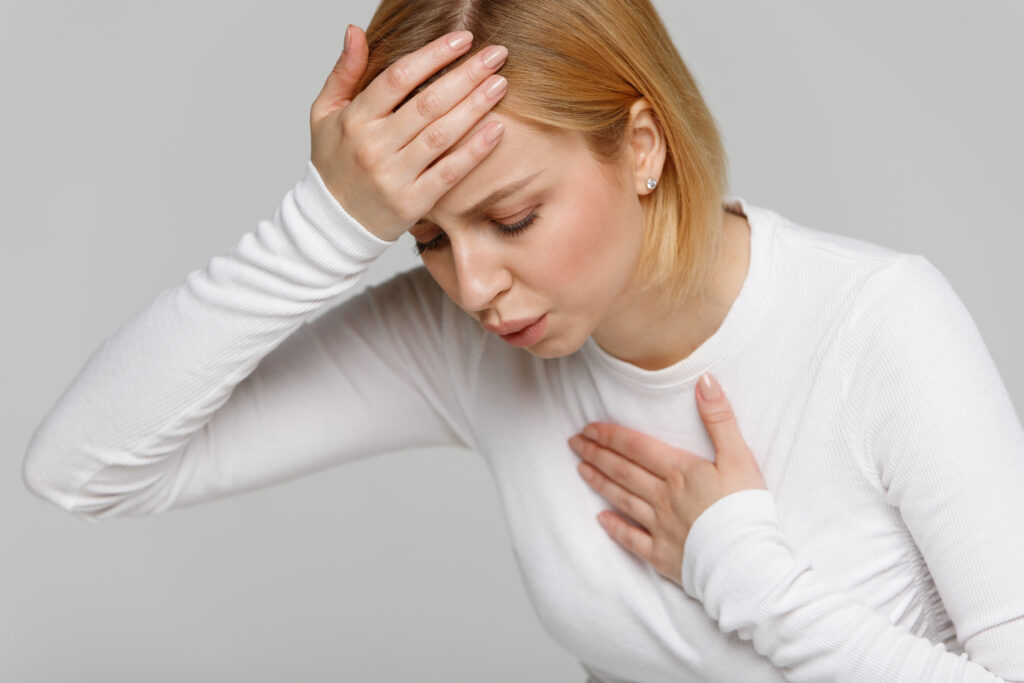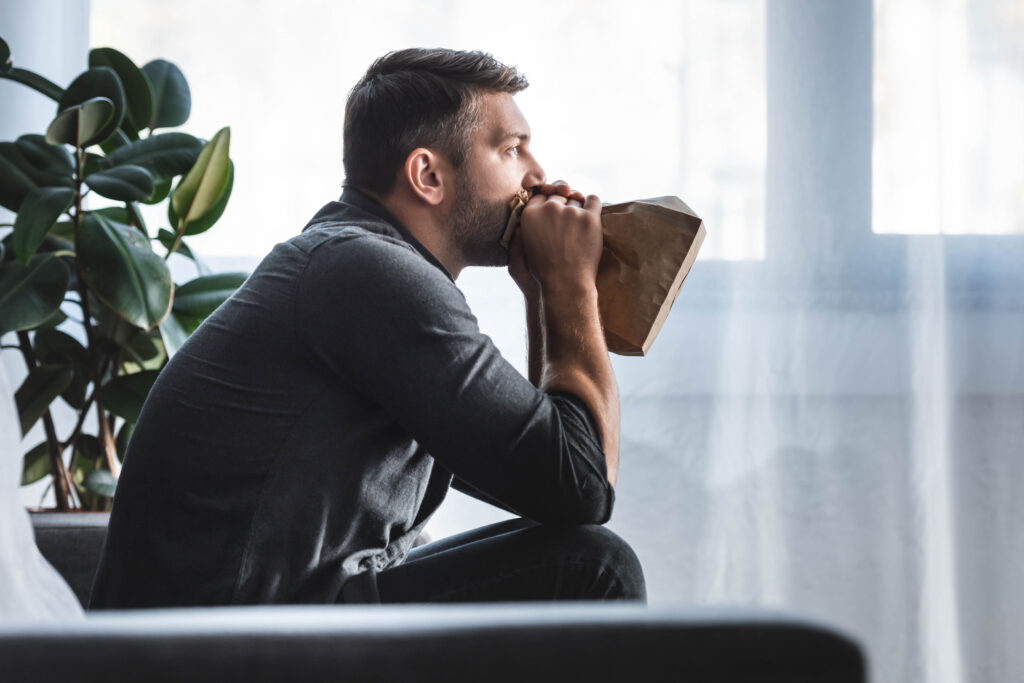
Palpitations, shortness of breath and dizziness can cause panic. Often these symptoms are not caused by diseases. Finding physical symptoms in panic attacks is rare. Without an apparent cause, they are most likely severe panic attack symptoms.
People affected by panic disorder suspect a life-threatening condition behind the symptomatology. The Fear before a loss of control usually turns out to be unrealistic. Can panic attacks in the Sleep Cause symptoms? This is also possible.
Panic attack symptoms can be very distressing. When they occur repeatedly, it makes sense to take action. Anxiety and panic attack symptoms occur at any time for no apparent reason. The more frequent and severe they are, the more the fear of the next panic attack grows. In this article you will learn how to recognize panic attack symptoms and how to successfully cope with them.
Mild panic attack symptoms may occur during severe mental or physical stress. The challenge is to distinguish panic attack symptoms from physical discomfort. Are headaches conceivable as panic attack symptoms? A panic disorder manifests itself through a variety of signs.
Typical panic attack symptoms are:
Most of the time, the sensations disappear as quickly as they came. Sometimes panic attack symptoms last all day. Attentive observation of the body and its reactions can intensify the symptoms.
Panic attack symptoms are often caused by stress. In the case of mental stress, overwork or workplace bullying the stress level skyrockets. If you work under time pressure, headaches can occur as panic attack symptoms.
Panic attacks can cause a wide variety of sensations. Without warning, symptoms such as chest pain, shortness of breath or nausea occur. Often panic attack symptoms affect the stomach and intestines. For fear of suffering from a dangerous disease, panic attack symptoms are often overestimated.
Most often, panic attack symptoms are relatively harmless, but they cause great discomfort. In extreme cases, they can significantly reduce the quality of life. Usually, a panic attack subsides within five to ten minutes. Often panic attack symptoms are still noted afterwards. These can be trembling, sweaty hands, malaise or exhaustion. Body and soul need some time to find their balance again.
How often panic attack symptoms occur depends on health status, lifestyle, and any underlying medical condition.

Do you worry about having a panic attack? Do you often feel strong fears for no reason? Are you burdened by unresolved problems? Are you often stressed?
Do you find it difficult to relax and calm down? Panic attack symptoms occur more often in difficult situations than in a relaxed state.
Can panic attack symptoms trigger breathing difficulties? Breathing difficulties are not the trigger, but arise from the brain's reaction to a perceived danger. You can recognize panic attack symptoms because they are temporary and stop on their own.
Every person is afraid from time to time. The fear that the cute dog might suddenly bite is understandable. If you avoid leaving your home because you are afraid of having an accident, you are dealing with panic attack symptoms. Often the perceptions are so extreme that behind panic attack symptoms heart attack or another life-threatening disease is suspected.
Can panic attacks symptoms promote abdominal pain? Anxiety does not trigger physical illness. However, it is possible that pre-existing stomach problems may be more noticeable during an anxiety attack. If the symptoms do not go away on their own, going to the family doctor is the best option. Before panic attack symptoms are treated, it is important to rule out physical illnesses.
What does a panic attack actually feel like? It's a little different for each person. Panic attack symptoms can be mild, moderate or severe. Sometimes panic attack symptoms occur at night or are felt exclusively during the day.
The 20 typical symptoms:
Excessive anxiety becomes noticeable through mild panic attack symptoms. The first signs of panic attack symptoms can be slight trembling, muscle cramps and sweating. Nighttime panic attack symptoms are especially feared.
Intense feelings of panic are often based on unprocessed problems. At night, the brain stores the information absorbed during the day. During sleep, panic attack symptoms such as sweating, trembling, heat or cold shivers may occur.
Do you think about problems before going to bed? Do you lie awake for a long time because you are worried about your job, your Relationship or do your university degree? Thereby you create the conditions for panic attack symptoms!
Depression and panic attack symptoms are difficult to distinguish from each other. Anxiety and panic affect not only adults, but also children. However, panic attacks in children cause symptoms similar to those of adults. Panic attack symptoms in children are usually treated with behavioral therapy or relaxing Measures treated. If panic attack anxiety disorder symptoms are particularly persistent, medication (antidepressants) is used.
Panic attack symptoms can occur individually. Most often, several sensations of discomfort are felt at the same time. The three most commonly mentioned panic attack symptoms are:
Palpitations are a common panic attack symptom. Due to feelings of anxiety, the pulse increases and the heart beats faster. The fast heartbeat is perceived as threatening.
Do symptoms already exist before panic attacks? Heart palpitations should be medically clarified. You can counteract palpitations by controlling your breathing. Breathe consciously and deeply into your stomach. After a few minutes you will feel a clear relief.
The feeling of suffocation increases panic. Many people are not aware that panic attack symptoms such as shortness of breath are increased by panic thoughts. Calm breathing helps in this case as well. Breathing exercises are suitable for managing breathing difficulties and thus the symptom of a panic attack. Learn effective breathing techniques to help you feel stronger and better cope with panic attack symptoms.
Dizziness without physical cause is usually the symptom of a panic attack. If you are afraid of losing control, dizzy spells may occur. However, the feeling of fainting is not based on a realistic assessment.
Dizziness attacks without physical cause are panic attack symptoms. The enormous inner tension can cause dizziness. Relaxation methods like yoga, autogenous training or meditation help to reach the inner center.

Coping with panic attacks is a challenge. Before you decide on therapy or other supportive measures such as coaching, the panic attack symptoms causes should be explored. Does an anxiety disorder trigger panic attack symptoms? In their symptomatology, anxiety and panic disorders are similar.
In coaching, the causes of your panic attack symptoms are worked out. Your coach supports you in recognizing even silent panic attack symptoms. The goal of a coaching session is to guide you to help yourself. The focus is on the development of individual solutions.
A good coach accompanies and encourages. You learn to deal with challenges on your own and to develop suitable solutions. Sometimes panic attacks and depression symptoms are an indication that you are overburdened with your life situation or that you are in a difficult situation. unhappy are. Release inner blockagesthat make you unhappy and strengthen your self-confidence.
With the support of a professional coach, you develop understanding of your panic attack symptoms and overcome them. A Coaching can help you:
Understanding panic attack symptoms is the first step to successful to cope. As a self-help guide, coaching helps you work through issues that can trigger panic attack symptoms. Recognize your challenges and solve your internal blockadesyou look forward to an easy and carefree life.

